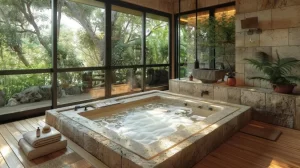Plumbing is an essential part of any building, whether it’s a house, apartment, office, or industrial facility. The network of pipes that carries water and gas plays a vital role in everyday life, and choosing the right material for these pipes is crucial. In this article, we will explore the different types of pipes used in plumbing, such as PVC, copper, PEX, and galvanized iron, and their common applications. If you’ve ever wondered which type of pipe is best for your project or need a better understanding of the available options, keep reading!
PVC Pipes (Polyvinyl Chloride) PVC is one of the most common materials used in residential plumbing. It is known for being cost-effective, durable, and corrosion-resistant. PVC is manufactured in two main types: rigid PVC and flexible PVC.
Rigid PVC Rigid PVC is widely used in cold water plumbing and drainage systems. Its characteristics include:
- Durability: Rigid PVC is corrosion-resistant and doesn’t deteriorate over time, making it ideal for long-term applications.
- Cost-effective: It is an economical choice for plumbing projects, especially for drainage systems.
- Easy installation: Rigid PVC pipes are lightweight and easy to cut and install. They don’t require welding.
- Chemical resistance: They are resistant to most household chemicals.
- Non-conductive: PVC doesn’t conduct electricity, making it safe in situations where electricity is a concern.
Flexible PVC Flexible PVC, also known as vinyl tubing, is used in applications where flexibility is required. Its characteristics include:
- Versatility: Flexible PVC is suitable for both hot and cold water systems, as well as for irrigation and pool systems.
- Flexibility: It can be bent and curved as needed, making installation in tight spaces easier.
- Corrosion resistance: Like rigid PVC, flexible PVC is corrosion-resistant.
- Cost-effective: It is an economical option for projects that require flexibility.
PVC is widely used in residential plumbing for cold water distribution and drainage, but it’s not recommended for hot water applications as it can soften at high temperatures.
Copper Pipes Copper is one of the oldest materials used in plumbing and remains a popular choice. Copper pipes are known for their durability and ability to withstand high temperatures. They are divided into two main types: rigid copper and flexible copper.
Rigid Copper Rigid copper pipes are famous for their durability and corrosion resistance. Their characteristics include:
- Durability: Copper is corrosion-resistant and can last for decades.
- High-temperature resistance: Copper pipes can handle high temperatures and are ideal for hot water systems.
- Safety: Copper is non-combustible, making it safe for plumbing.
- Water quality: Copper does not negatively affect drinking water quality.
- UV resistance: It can be used in outdoor applications without concerns about damage from exposure to sunlight.
Flexible Copper Flexible copper is easier to bend and curve than rigid copper, making it ideal for installations that require turns and bends. Its characteristics include:
- Flexibility: It can be bent and curved as needed, facilitating installation.
- Corrosion resistance: Like rigid copper, flexible copper is corrosion-resistant.
- High-temperature resistance: It is suitable for hot water systems.
- Easy soldering: It can be easily soldered.
Copper pipes are common in residential and commercial water supply systems, but their main drawback is their cost compared to other materials.
PEX Pipes (Cross-linked Polyethylene) PEX is a plastic material used in plumbing systems since the 1970s. It offers advantages in terms of flexibility and ease of installation. PEX comes in three main variants: PEX-A, PEX-B, and PEX-C.
PEX-A PEX-A is known for its high flexibility and freeze damage resistance. Its characteristics include:
- Flexibility: It can be bent and curved without the risk of damage.
- Freeze resistance: It can withstand expansions and contractions due to water freezing without breaking.
- Easy installation: It is used with expansion connections or compression rings, simplifying installation.
- Low risk of leaks: Expansion connections help prevent leaks.
PEX-B PEX-B is the most common type of PEX and is known for its cost-effectiveness. Its characteristics include:
- Good flexibility: Although not as flexible as PEX-A, it is sufficient for most applications.
- Easy installation: It is used with compression ring or crimp ring connections, making installation straightforward.
- Cost-effective: It is an economical choice for plumbing projects.
PEX-C PEX-C is similar to PEX-B in terms of flexibility and installation method. Its characteristics include:
- A good balance between flexibility and cost: It offers adequate flexibility and is more economical than PEX-A.
- Easy installation: Like other PEX types, it is installed with compression ring or crimp ring connections.
PEX pipes are popular in residential plumbing due to their ease of installation and freeze resistance. They are used in both potable water and heating systems.
Galvanized Iron Pipes Galvanized iron is a less common material in modern plumbing but is still found in some applications. Galvanized iron pipes are made of iron covered with a layer of zinc to protect them from corrosion.
- Durability: Galvanized iron is corrosion-resistant, making it suitable for outdoor applications and where increased durability is needed.
- High-pressure resistance: These pipes can handle high pressures, so they are used in irrigation systems and industrial applications.
- Use in gas applications: Galvanized iron pipes are often used for gas systems due to their durability and resistance.
Despite these advantages, galvanized iron pipes have some disadvantages, such as their weight and installation difficulty. Additionally, over time, the zinc layer can wear off and corrode, reducing the pipes’ lifespan.
Choosing Pipe Material The choice of pipe material largely depends on the specific needs and requirements of the project. Here are some key considerations when selecting the right material:
- Application type: Will the pipe be used for cold water, hot water, heating systems, or gas? Each material has its limitations and advantages based on the application.
- Budget: The cost of the material and the labor required for installation are significant factors to consider.
- Durability: How long is the system expected to last? Some materials are more durable than others.
- Ease of installation: Ease of installation and the availability of tools and fittings can influence material choice.
- Local regulations: Ensure compliance with local building regulations and codes when selecting pipe material.
In summary, the choice of pipe material is a crucial aspect of any plumbing project. Each type of pipe has its own advantages and disadvantages, and the decision will depend on the specific project needs. It’s important to consult with a plumbing professional or engineer before making a final decision to ensure that local requirements and regulations are met. With the information provided in this article, you are better equipped to make informed decisions about pipe selection in your next plumbing project.



















